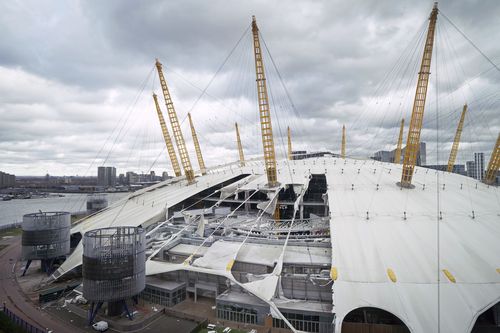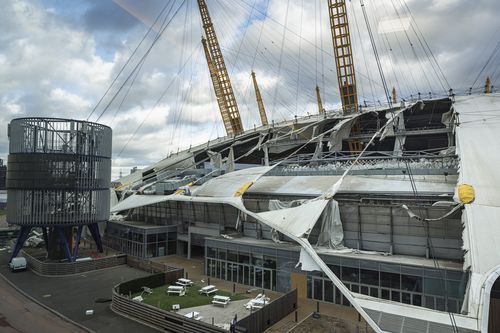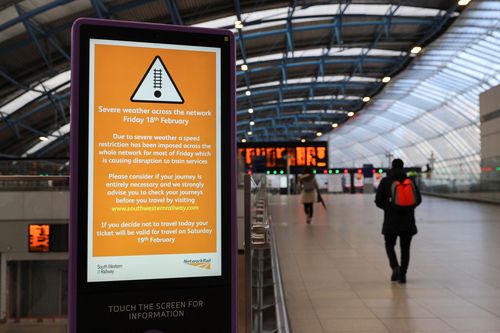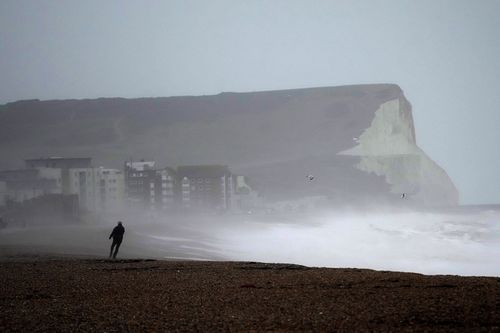

The first fatality from the storm was confirmed Friday afternoon after a man was killed by falling tree in County Wexford, Ireland.
The UK Met Office expanded its rare "danger-to-life" weather alert on Friday morning to include most of the south of England and some of Wales, before Eunice picked up speed with winds as high as 196km/hr, the fastest on record in England. High wind speeds is what make wind storms intense.
A CNN reporter witnessed a rooftop flying off a home in the southwestern London area of Surbiton. The roof crushed a car parked on the street.
The O2 Arena in London, formerly known as the Millennium Dome, also suffered damage due to high winds, with parts of the roof being ripped to shreds.
London Fire Brigade said that there were no reports of any injuries as around 1,000 people were evacuated from the building, which hosts major events including concerts and features restaurants, bars, shops and a cinema.
However, the London Fire Brigade has declared Storm Eunice a "major incident" due to the high volume of calls.


A number of tourist attractions in England, including the London Eye, Legoland and Warwick Castle, closed ahead of the storm, as did the Royal Parks.
"I urge all Londoners to stay at home, do not take risks, and do not travel unless it is absolutely essential,″ Mayor Sadiq Khan said.
Social media video showed a building housing lifeboats with part of its rooftop blown off at Sennen beach in the country of Cornwall, where strong winds were pushing waves above a seawall.
Police in Cornwall and neighbouring Devon said they had received high volumes of calls about flying debris, collapsed roofs and fallen trees.

Residents also posted images on social media of collapsed fences and trees in roads.
As dozens of flights were cancelled across London's major airports, more than 200,000 people tuned in to watch a live stream on YouTube of planes landing at London's Heathrow.
The aircraft were seen battling strong gusts as they came into land, some of them wobbling mid-air, others skidding from side to side once they hit the runway.
The video, on the Big Jet TV channel, was accompanied by comical commentary by presenter Jerry Dyer, who kept viewers entertained by offering words of encouragement to the pilots, at one point saying: "Come on mate, you can do it!"

British Airways said it was grounding a number of planes and expected "significant disruption," but that most flights would go ahead as planned.
"Safety is our number one priority, and we're cancelling a number of flights," British Airways said in a statement.
The airline said it was looking at deploying larger aircraft where possible to better withstand the weather.

Rail companies have urged customers to reconsider their plans, with blanket speed restrictions in place for most lines across the country.
In a statement Friday, Network Rail warned of high winds blowing trees and other debris onto railway lines, which then block trains and cause delays and cancellations.
Authorities are expecting gusts to cause travel delays, power cuts and possible mobile phone coverage outages throughout Friday.
The UK government is set to hold a meeting of its COBRA emergency committee to discuss the storm.
The Army is on "high readiness stand-by" to respond if needed, Home Office Minister Damian Hinds told Sky News.
A sting jet is a very narrow and concentrated blast of powerful, upper-level winds that can form inside powerful weather systems. It descends to the the Earth's surface and can last a few hours, potentially causing damage to life and property, according to CNN meteorologist Derek Van Dam.
"The 'sting' refers to the cloud formation it creates, which resembles a scorpion's stinger," he said.
Eunice is the second named storm to hit Europe in two days, with the first storm (Storm Dudley) battered parts of Scotland, northern England and Northern Ireland Wednesday, leaving thousands of homes without power and killing at least five people in Germany and Poland.

Hannah Cloke, professor of Hydrology at Britain's University of Reading, urged people to stay home where possible.
She said people should not to take the red alert "lightly," as the winds were likely to uproot trees and roof tiles.
"If you're hit by one of those you will be seriously hurt or killed. Wind that strong will sweep people and vehicles off streets, and topple electricity lines," she said.
Peter Inness, a meteorologist at the University of Reading in England, attributed the storms to an unusually strong jet stream over the eastern Atlantic Ocean, with winds close to 322km/hr at high altitudes.
"A strong jet stream like this can act like a production line for storms, generating a new storm every day or two," Inness said. "There have been many occasions in the recent past when two or more damaging storms have passed across the UK and other parts of Europe in the space of a few days."
The Environment Agency has issued 10 severe flood warnings, another indicator of life-threatening weather conditions.
"After the impacts from Storm Dudley for many on Wednesday, Storm Eunice will bring damaging gusts in what could be one of the most impactful storms to affect southern and central parts of the UK for a few years," said Paul Gundersen, the Met Office's chief meteorologist.
"The red warning areas indicate a significant danger to life as extremely strong winds provide the potential for damage to structures and flying debris."
The storm is expected to hit northern Germany on Friday afternoon and sweep eastward overnight. A flood warning was issued for Germany's North Sea coast on Friday. Meteorologists warned Friday's storm could cause more damage than the earlier weather system, which triggered accidents that killed at least three people, toppled trees and damaged roofs and railroad tracks.




























